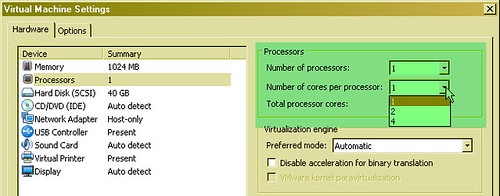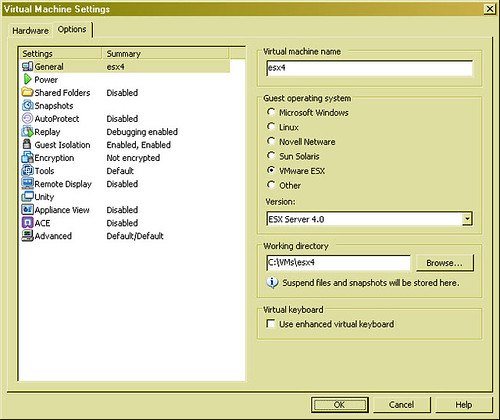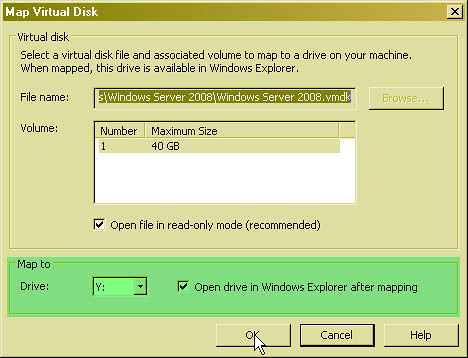If you’re a regular follower of my blog, you’ve probably noticed that I typically focus on Datacenter products. I am a VMware Workstation user as well. VMware’s inaugural product is the first hypervisor I ever used and has a lot to do with my career shift and focus on the exciting world of virtualization. Although I don’t use Workstation quite as much as I used to, I still like to keep current with new releases. As a Virtual Infrastructure user, one reasons for this is that I get a preview of features in Workstation that will eventually make their way to Virtual Infrastructure in the product development cycle.
VMware Workstation 7.0 was released on October 27th and boasts an array of new features as well as support for new guest operating systems. I upgraded last week and started taking a look around. Having not read the “What’s New” release notes yet, I had noticed some features that, to me, looked new or improved.
The first thing I noticed about VMware Workstation 7.0, before installing it, is that VMware did away with separate license keys for Windows and Linux distributions. It has absolutely bugged me for years that I could not transfer my VMware Workstation installation from Windows to Linux or from Linux to Windows without purchasing an additional license. One license key now works with both Windows and Linux versions of VMware Workstation. I validated this by looking it up on VMware’s website. Here’s what I found:
- “Q: Can I switch between VMware Workstation 7 for Windows and Linux?
- A: Yes. Starting with VMware Workstation 7, you can switch between Windows and Linux version of VMware Workstation using the same license key. If you decide to switch host operating systems, you must uninstall Workstation from the host operating system you no longer plan to use. If you plan to run VMware Workstation 7 on both a Linux and Windows host, you need to purchase two licenses.”
Once installed, the first new feature that jumped out at me was during the creation of a new VM. The ability to assign CPU cores to a guest OS and its applications. Differentiating between CPU sockets and CPU cores has obvious licensing advantages for both applications and operating systems which licenses per socket. Support for 4 processors is also apparent:

The next item I saw was the ability to select VMware ESX as a guest operating system. This is handy new feature that will save time by eliminating the need to hack the .vmx file or manually add advanced settings in order to run an embedded hypervisor as well as nested VMs. I’ll add that for some reason, both ESX and ESXi seem to run a lot faster or more efficient in VMware Workstation 7. Two or more of the same workloads running concurrently in VMware Workstation 6 on my Dell Latitude E6400 laptop would create loads of I/O congestion resulting in long delays in keyboard and mouse response, as well as screen redraw. I can’t account for why but I’m certainly not complaining:

Next up is a virtual disk “Utilities” menu…

…which reveals an option to mount the virtual disk as a Windows drive letter in the host operating system. In the old days, VMware offered a VMware-mount.exe command line utility to accomplish this task. The integrated GUI version is a nice touch. Mounting a .vmdk disk in your native file system allows such tasks as out of band file injection, data rescue, etc. I’ve used the old command line utility many times in the past for refreshing DR images offline with application code updates:

The Virtual Network Editor looks like it got a face lift, with most of the configurable items streamlined into a single property sheet for better visibility and ergonomics:

This is cool, and sort of uhh… Citrix or Terminal Services ‘ish. Driverless printing from guest through the host operating system. A Virtual Printer device can be added in the virtual machine settings (the guest OS must be powered off)…

…which maps host printer connections (both local and network printers) inside the guest VM. Automatically imported printers have the comments “Printer created by TPAutoConnect“, indicating integrated technology from ThinPrint in VMware Tools:

This was the extent of my observations thus far while using VMware Workstation 7.0. If any of the items I talked about above existed in previous versions of VMware Workstation, please let me know. Since I do not use Workstation as much, it is possible that I missed an item or two while using an earlier version.
I decided to look at the VMware Workstation 7.0 Release Notes to see the complete list of improvements and new features:
New Support for 32-Bit and 64-Bit Operating Systems
Operating System |
Host and Guest Support |
|---|---|
| Windows 7 Home Basic Windows 7 Premium Windows 7 Business Windows 7 Enterprise Windows 7 Ultimate |
Host and guest |
| Windows 2008 SP2, R2 | Guest |
| Windows Vista SP2 | Guest |
| Debian 5 | Guest |
| Ubuntu 9.04 | Host and guest |
| Red Hat Enterprise Linux 5.3 | Host and guest |
| CentOS 5.3 | Guest |
| Oracle Enterprise Linux 5.3 | Guest |
| OpenSUSE 11.x | Host and guest |
| Mandriva 2009 | Host and guest |
| SUSE Linux Enterprise 11.x | Host and guest |
New Features in VMware Workstation
- Windows 7 — Create and run Windows 7 32-bit and 64-bit virtual machines using VMware Workstation. VMware Workstation has been enhanced for performance and to take advantage of the new Windows 7 features including Live Thumbnails and Aero Peek.
- Aero Glass — A new Windows Display Driver Model (WDDM) graphics driver has been developed for Windows Vista and Windows 7 virtual machines. The WDDM driver can display the Windows Aero user interface, OpenGL 1.4, and Shader Model 3.0. For more information on the VMware recommended graphics hardware, see the VMware Workstation User’s Manual.
- Windows XP Mode Compatible — Import a Windows XP Mode virtual machine using VMware Workstation 7.0 and run the virtual machine without being prompted to enter a Windows XP license key. VMware Workstation enables the Windows XP Mode virtual machine to take advantage of more than one processor, render high-end graphics, integrate seamlessly with Unity, and transfer files easily with drag and drop, and shared folders. VMware Workstation also has the ability to run concurrently with Windows XP Mode.
- 3D Graphics Improvements for Windows XP guests — OpenGL 2.1 and Shader Model 3.0 support is now available for Windows XP virtual machines. The XPDM (SVGAII) graphics driver works with Windows XP, Windows Vista, and Windows 7. However, only Windows XP virtual machines install the XPDM graphics driver by default. To switch graphics drivers in the guest operating system, see How to Switch Between SVGAII and WDDM Drivers.
- vSphere 4.0 and ESX Support — Install and run ESX 4.0 as a guest operating system. VMware Certified Professionals (VCPs) and technical professionals can install the latest server virtualization software and experiment with server setup, conduct training, show demos, and test production configurations. Running ESX as a guest eliminates the need to have spare hardware available to run ESX natively and enables ESX to run on systems that are not listed on the ESX hardware compatibility list (HCL). For more information on the supported processors and host operating systems, see Considerations for Running an ESX Guest.
This feature is intended for educational and demonstration purposes only and should not be used in production environments. To use this feature, you must download vSphere 4.0 from the VMware Web site and follow the installation documentation provided with vSphere to install ESX. - Virtual Printing — Print from virtual machines without mapping network printers or installing printer drivers in the virtual machine. With virtual printing enabled in the virtual machine setting, all of the printers installed on the host operating system are available in the guest operating system. This functionality is enabled through a partnership with ThinPrint, Inc.
- Four-Way SMP — Create and run virtual machines with a total of four processor cores, which can consist of four single-core processors, two dual-core processors, or one quad-core processor like the new Intel i7.
- 32GB Guest Memory — Run virtual machines with up to 32GB of memory using VMware Workstation.
- 256-bit Encryption — Secure your virtual machines with AES256-bit encryption to prevent unauthorized users from accessing or running the configuration files.
- AutoProtect —Schedule snapshots of your virtual machine to be created at a regular interval to ensure that you always have a snapshot available to revert to when needed.
- Advanced Linux Sound Architecture (ALSA) — ALSA significantly improves the sound of virtual machines running on a Linux host and streams the audio from each virtual machine on a separate channel so that multiple virtual machines can be heard simultaneously.
- Cross-Platform License Keys — Use the VMware Workstation 7.0 license key on both the Windows and Linux versions. Make sure you read the EULA for the terms and conditions that must be met when switching platforms.
- Pause a Virtual Machine — Free your CPU resources instantaneously without powering off or suspending the virtual machine.
- Expand Virtual Disks — Increase the size of the virtual disk from within VMware Workstation. For Windows Vista and Windows 7 guests, the disk partitions can be adjusted without the use of additional software.
- Compact Virtual Disks — Reclaim unused space from a virtual disk so that the host or another virtual machine can use it.
- Shared Folder Compatibility — Increased compatibility with many Windows applications that previously were unable to read or write files to shared folders.
- On-Demand VMware Tools Download — On-demand download capability provides the latest VMware Tools for the guest operating system. This feature reduces the overall download size of VMware products by downloading only the required set of VMware Tools and and enables VMware to release new versions frequently.
- Drag and Drop Enhancements — Drag and drop enhancements include support for new file types including images and formatted text and extend the existing ability to drag and drop files to a broader set of guest and host operating systems.
- Virtual Network Editor — User interface enhancements have simplified creating and configuring virtual networks.
- Fuse Mount for Linux — Use Fuse to mount .vmdk disks on to the file system of Linux hosts.
- Simplified Collection of Support Information — Gather detailed information about multiple virtual machines and the host machine at the same time. The information is packaged in a compressed file so that you can email it to VMware support or post it on the VMware Workstation forums.
- IPv6 Support — Create a bridged connection to an IPv6 network on VMware Workstation virtual machines.
Developer Tools
- Replay Debugging — Enhancements in replay debugging make the feature faster and easier to use. Developers can attach to a particular process instance, attach to a process in the middle of a recording, and ensure that the executables and symbols on the host machine match the guest. Developers can remotely view the exact state of the machine when the system failed and replay the recording to see the circumstances that led the system to fail. For more information about replay debugging, see the new Integrated Virtual Debugger for Visual Studio Developer’s Guide and technical note for Replay Debugging on Linux .
- SpringSource Tools Suite Integration — Use the latest version of the SpringSource Tools Suite to run and debug Java applications in a VMware Workstation virtual machine without leaving the development environment. You can download the latest SpringSource Tools Suite from the Spring Source Web site.
- Remotely Debug C and C++ Applications for Eclipse — Set a remote debugging session inside a controlled C and C++ environment where the guest operating system is different from the host. For more information about remotely debugging C and C++ for Eclipse, see the Integrated Virtual Debugger for Eclipse Developer’s Guide .
- VMware Tools Configuration Utility – Use the new VMware Tools command-line interface (CLI) to automate configuration of VMware Tools in guest operating systems. With CLI you can modify VMware Tools settings, shrink virtual disks, connect and disconnect virtual devices, and more. For information on the VMware Tools configuration utility, see the new VMware Tools Configuration Utility User’s Guide.
Additional VMware Workstation 7.0 links:
http://www.vmware.com/products/workstation/new.html
http://www.vmware.com/files/pdf/ws_datasheet.pdf
http://www.vmware.com/support/pubs/ws_pubs.html
http://www.vmware.com/support/ws7/doc/releasenotes_ws7.html
There is some good stuff in this release. More than I originally thought. I’d like to take this moment to admit guilt in showing a lack of enthusiasm when Workstation 7 was first launched. My initial understanding of the major new features amounted to Aero support and VMware ESX as a guest OS. My reaction was “who cares”. I take it back. This is a solid release with increased configuration maximums as well as new and improved features.

















I love this version, it has helped me get to know ESX alot more, but one of the final things I had planned was enabling FT, but as it didn’t work stating virtualization wasn’t enabled in firmware/BIOS I guess this is one of the nasty limitations if you want to go THAT far.